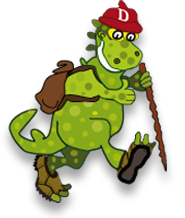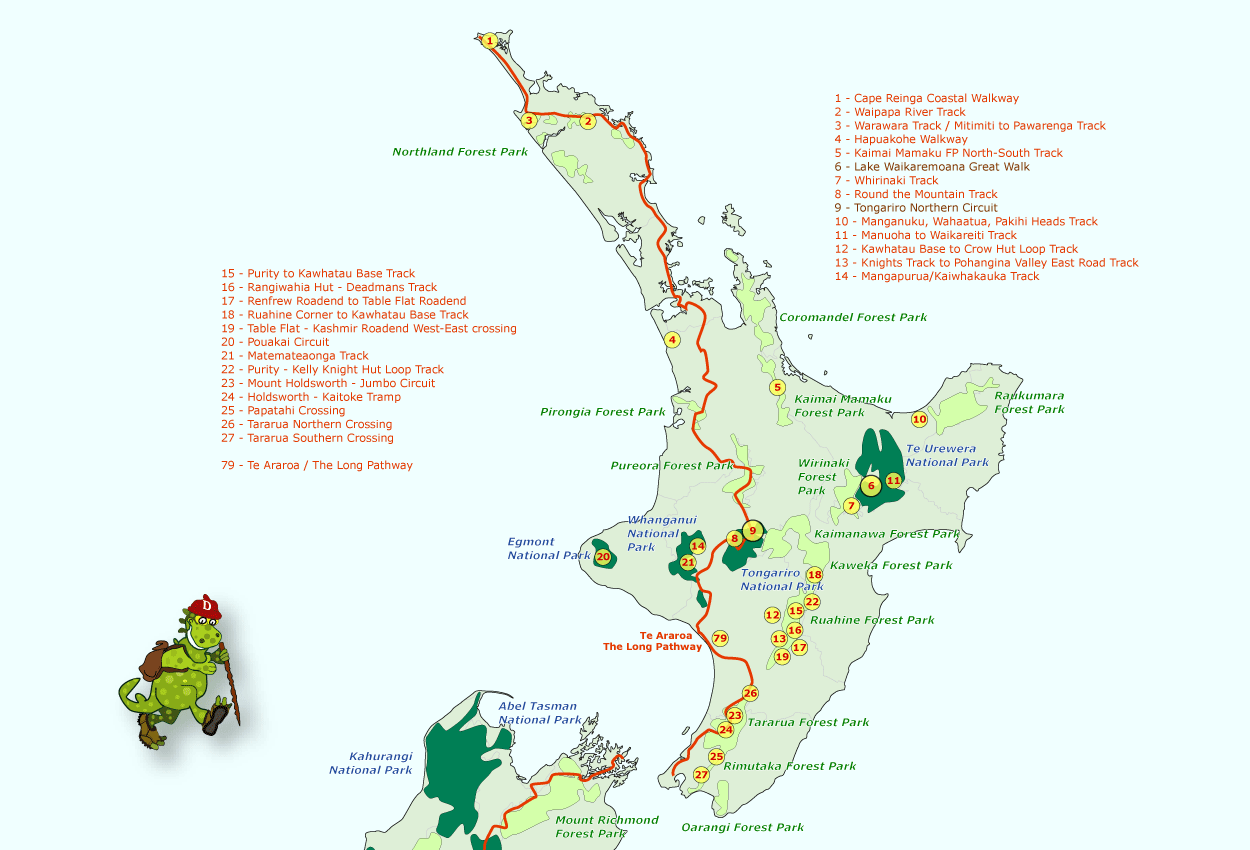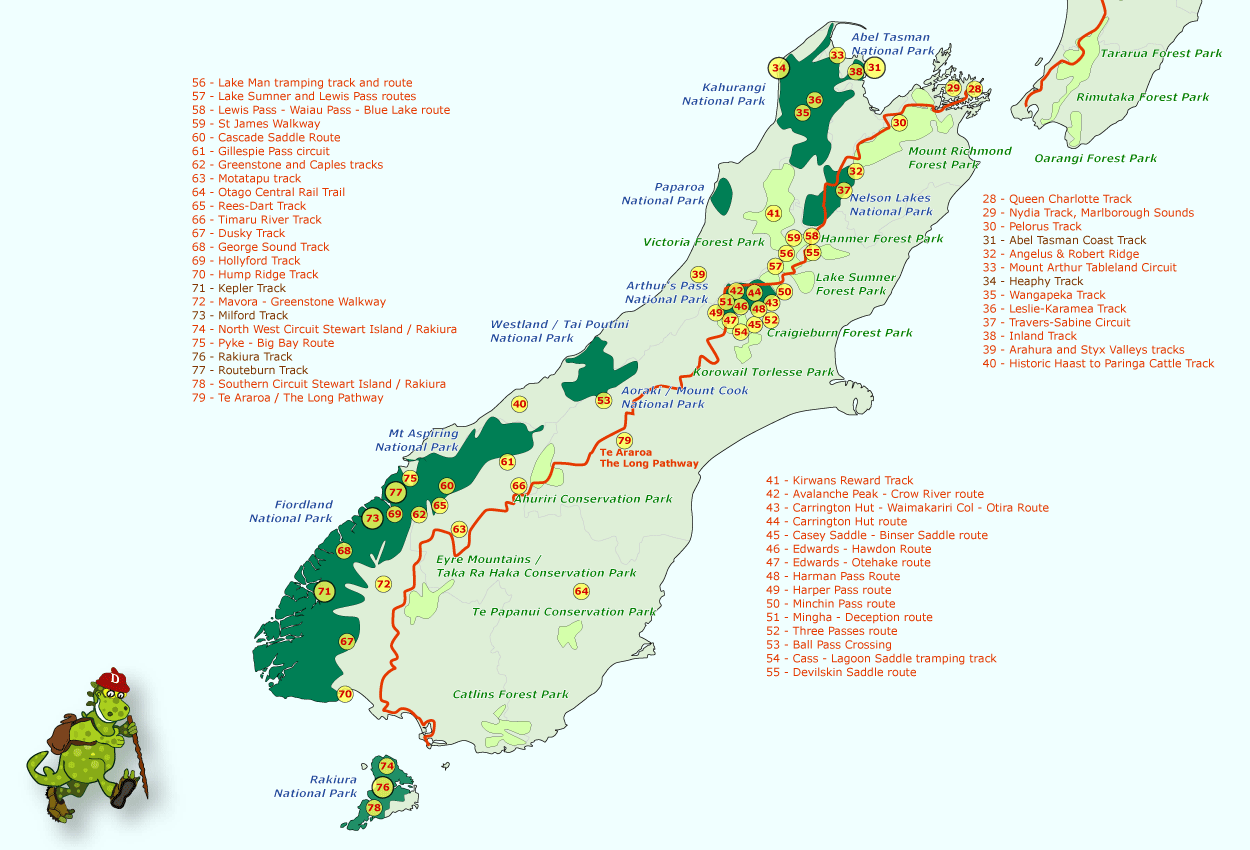Nouvelle-Zélande
Description
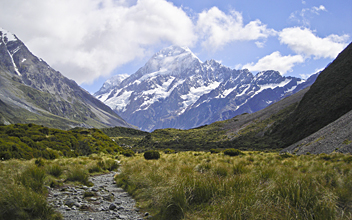 New Zealand is paradise for hikers. Tramping, as hiking or walking is called here, is very popular and well organised. Most tramps are inside one of New Zealand’s 14 NPs and 19 National Forests.
New Zealand is paradise for hikers. Tramping, as hiking or walking is called here, is very popular and well organised. Most tramps are inside one of New Zealand’s 14 NPs and 19 National Forests.
From the northern tip to Stewart Island in the south, New Zealand stretches out for 1.600 km, and the country has a 10% larger area than Great Britain. Thanks to high rainfall, its elongated north-south position, geology, mountains and winds, the country offers an enormous variety in landscapes. You will find countless rivers and lakes filled with fish, lush rainforests, alpine ridges and active volcanoes. The coastline is seemingly endless and varied, and dotted with small beaches. In all these landscapes hiking trails have been laid out. Ideal if you are looking for wilderness and isolation.
Trails, or tracks as they are called locally, and so-called backcountry huts are mostly maintained by the Department of Conservation (DOC). Tramping is possible on all levels of difficulty. The DOC distinguishes 6 Track Categories:
- Easy Access Tracks (very short)
- Short Walks
- Walking track (2429 km): day hikes
- Great walks (380 km) and Easy tramping tracks (895 km): track is generally well formed, may be steep, rough or muddy
- Tramping tracks (7803 km): track is mostly unformed with steep, rough or muddy sections
- Routes (1458 km): challenging; Track is mostly unformed with steep, rough or muddy sections
A special category are the so-called 9 Great Walks. In fact there are only 8, because the Whanganui Journey is a paddling route. These Great Walks are very scenic, not too difficult, and consequently most popular. During high season – from mid December until late January – these are best avoided. The Great Walks are:
- Lake Waikaremoana Great Walk, 42 km, 4 days
- Tongariro Northern Circuit, 50 km, 4 days
- Whanganui Journey - paddle, 144 km, 5 days
- Abel Tasman Coast Track, 51 km, 5 days
- Heaphy Track, 78 km, 5 days
- Routeburn Track, 32 km, 3 days
- Milford Track, 54, 4 days
- Kepler Track, 60 km, 4 days
- Rakiura Track, Stewart Island, 36 km, 3 days
All tramps have huts and camp sites. You will need to bring your own food. Also bring your own stove for cooking, except on the Great Walks where the huts have a kitchen with stove. Most huts are basic and cheap, The better and popular ones may be staffed by a warden. There are three categories of huts:
- 1000 huts in the NPs. Payment with tickets purchased in advance at for instance DOC visitor information centres. You can also buy a Backcountry Hut Pass, valid for one year, and a good deal if used for 10 nights or more.
- There are a few Alpine Service Huts, high up in the mountains, which are a lot more expensive
- Great Walk Huts: these have their own separate ticket system and require a special Great Walks Pass. In addition these Great Walks, because of their popularity, are bookable online (DOC) and consequently frequently booked-out during high season.
Summer holidays in New Zealand run from mid December until late January. In this period walking trails are very busy. The Great Walks will be fully booked if you haven’t booked early. If you can avoid the high season, from mid November and until mid April is also a good time for hiking, although you may encounter snow high up in the mountains. Weather is changeable at all times.
Carte
Sentiers
- Abel Tasman Coast TrackGPX
- Angelus and Robert Ridge
- Arahura and Styx Valleys tracks
- Avalanche Peak – Crow River route
- Ball Pass CrossingGPX
- Cape Reinga Coastal Walkway
- Carrington Hut – Waimakariri Col – Otira Route
- Carrington Hut routeGPX
- Cascade Saddle Route
- Casey Saddle – Binser Saddle route
- Cass – Lagoon Saddle tramping track
- Devilskin Saddle route
- Dusky TrackGPX
- Edwards – Hawdon Route
- Edwards – Otehake route
- George Sound Track
- Gillespie Pass circuit
- Great Walks New Zealand
- Greenstone and Caples tracks
- Hapuakohe Walkway
- Harman Pass Route
- Harper Pass route
- Heaphy TrackGPX
- Historic Haast to Paringa Cattle Track
- Holdsworth – Kaitoke Tramp
- Hollyford TrackGPX
- Hump Ridge Track
- Inland TrackGPX
- Kaimai Mamaku North-South Track
- Kawhatau Base to Crow Hut Loop Track
- Kepler TrackGPX
- Kirwans Reward Track
- Knights Track to Pohangina Valley East Road Track
- Lake Man tramping track and route
- Lake Sumner and Lewis Pass routes
- Lake Waikaremoana Great Walk
- Leslie-Karamea Track
- Lewis Pass – Waiau Pass – Blue Lake route
- Manganuku Wahaatua Pakihi Heads Track
- Mangapurua Kaiwhakauka Track
- Manuoha to Waikareiti Track
- Matemateaonga Track
- Mavora – Greenstone Walkway
- Milford TrackGPX
- Minchin Pass route
- Mingha – Deception route
- Motatapu track
- Mount Arthur Tableland Circuit
- Mount Holdsworth – Jumbo Circuit
- North West Circuit Stewart Island
- Nydia Track, Marlborough Sounds
- Otago Central Rail Trail
- Papatahi Crossing
- Pelorus TrackGPX
- Pouakai CircuitGPX
- Purity - Kelly Knight Hut Loop Track
- Purity to Kawhatau Base Track
- Pyke – Big Bay Route
- Queen Charlotte TrackGPX
- Rakiura TrackGPX
- Rangiwahia Hut - Deadmans TrackGPX
- Rees-Dart Track
- Renfrew Roadend to Table Flat Roadend
- Round the Mountain TrackGPX
- Routeburn TrackGPX
- Ruahine Corner to Kawhatau Base Track
- Southern Circuit Stewart Island
- St James WalkwayGPX
- Table Flat - Kashmir Roadend West-East crossing
- Tararua Northern CrossingGPX
- Tararua Southern CrossingGPX
- Te AraroaGPX
- Three Passes route
- Timaru River Track
- Tongariro Northern CircuitGPX
- Travers-Sabine CircuitGPX
- Waipapa River TrackGPX
- Wangapeka TrackGPX
- Warawara Track
- Whirinaki Track
Régions
- Abel Tasman NP
- Ahuriri CP
- Aoraki or Mount Cook NP
- Arthur's Pass NP
- Bay of Plenty
- Canterbury
- Craigieburn FP
- East Coast
- Egmont NP
- Eyre Mountains CP
- Fiordland NP
- Hanmer FP
- Kahurangi NP
- Kaimai Mamaku FP
- Lake Sumner FP
- Marlborough
- Mavora Lakes Park
- Mount Aspiring NP
- Mount Richmond FP
- Nelson
- Nelson Lakes NP
- North Island
- Northland
- Northland FP
- Otago
- Pirongia FP
- Pureora FP
- Pyke Forest
- Rakiura NP
- Raukumara FP
- Rimutaka FP
- South Island
- Southland
- St James CP
- Tararua FP
- Te Urewera NP
- Tongariro
- Tongariro NP
- Waikato
- Wanganui
- Wellington
- West Coast NZ
- Western Ruahine FP
- Whanganui NP
- Whirinaki FP
Montagnes
Liens
Données
Rapports
Guides et cartes
Hébergement
Organisations
Voyagistes
GPS
Autre
Livres

United Kingdom
2022
- Lonely Planet Epic Hikes of Australia & New Zealand
- Lace up your hiking boots for the next in Lonely Planet`s highly successful Epic Hikes series, this time exploring 50 of Australia and New Zealand`s most rewarding treks and trails. From the Routeburn Track in New Zealand`s South Island to the Cape to Cape walk in Western Australia`s Leeuwin-Naturaliste National Park, we cover a huge variety of... Lire la suite
- Also available from:
- De Zwerver, Netherlands

Netherlands
2022
- Wandelgids Hikes of Australia and New Zealand | Lonely Planet
- Lace up your hiking boots for the next in Lonely Planet`s highly successful Epic Hikes series, this time exploring 50 of Australia and New Zealand`s most rewarding treks and trails. From the Routeburn Track in New Zealand`s South Island to the Cape to Cape walk in Western Australia`s Leeuwin-Naturaliste National Park, we cover a huge variety of... Lire la suite
- Also available from:
- De Zwerver, Netherlands

United Kingdom
- Wildboy: To the Edge and Back
- More Adventures Through Rugged, Remote New Zealand Lire la suite

United Kingdom
- Walking with the ANZACS
- The authoritative guide to the Australian battlefields of the Western Front Lire la suite

United Kingdom
- Wanderful New Zealand
- Hiking the 3,000 kilometre Te Araroa Trail Lire la suite

United Kingdom
- RED DEER WRITING A New Zealand Outdoors Memoir
- ( Colour Edition ) Lire la suite

Netherlands
- Short Walks in Auckland
- "Volcanoes" (Second edition) is part of a series of books encouraging Auckland, New Zealand residents and tourists alike to discover on foot the magnificence and uniqueness of Auckland city. In this edition, we take you on twelve walks over and around some of the Auckland region's 50 plus cones and craters. These walks have been selected to... Lire la suite
- Also available from:
- Bol.com, Belgium

Belgium
- Short Walks in Auckland
- "Volcanoes" (Second edition) is part of a series of books encouraging Auckland, New Zealand residents and tourists alike to discover on foot the magnificence and uniqueness of Auckland city. In this edition, we take you on twelve walks over and around some of the Auckland region's 50 plus cones and craters. These walks have been selected to... Lire la suite
Cartes

United Kingdom
- NZ2325 Plans in Lake Taupo (Taupomoana)
- Plans included:Western Bay 1:40,000Waihi Bay 1:20,000Motuoapa Bay 1:10,000Boat Harbour Kawakawa Point 1:5,000Nautical charts for New Zealand, created by Land Information New Zealand (LINZ), are printed on demand at Stanfords after your order is placed and processed. They provide a detailed coverage of the coastline with a varied range of scales... Lire la suite

United Kingdom
- NZ2862 Plans in the Auckland Islands
- Plans included:Smith Harbour to South Cape 1:50,000Enderby Island to Smith Harbour 1:50,000Nautical charts for New Zealand, created by Land Information New Zealand (LINZ), are printed on demand at Stanfords after your order is placed and processed. They provide a detailed coverage of the coastline with a varied range of scales - from overall... Lire la suite
United Kingdom
- NZ864 Apolima Strait
- Plan included:Savai`i Island Matautu Bay 1:50,000Nautical charts for New Zealand, created by Land Information New Zealand (LINZ), are printed on demand at Stanfords after your order is placed and processed. They provide a detailed coverage of the coastline with a varied range of scales - from overall route planning to detailed harbour... Lire la suite

United Kingdom
- Coromandel Pocket Map
- Coromandel region in a series of maps covering various districts of New Zealand, with each title combining a detailed road map with street plans of local towns, all with road and street indexes. The maps are published in two formats: handy Pocket Maps or Pathfinders with, as the publishers put it “Larger print so you don’t squint”.The road... Lire la suite

United Kingdom
- NZ5124 Plans in the Bay of Islands
- Plans included in this chart:Approaches to Opua 1:15,000Kerikeri Inlet and Te Puna Inlet 1:25,000Opua Wharf 1:6,000Nautical charts for New Zealand, created by Land Information New Zealand (LINZ), are printed on demand at Stanfords after your order is placed and processed. They provide a detailed coverage of the coastline with a varied range of... Lire la suite
United Kingdom
- NZ614 Tasman Bay / Te Tai-o-Aorere
- Plans included:Port Motueka 1:20,000Mapua 1:20,000Nautical charts for New Zealand, created by Land Information New Zealand (LINZ), are printed on demand at Stanfords after your order is placed and processed. They provide a detailed coverage of the coastline with a varied range of scales - from overall route planning to detailed harbour... Lire la suite

United Kingdom
- NZ6912 Plans in Stewart Island / Rakiura
- Plans included:Port Pegasus / Pikihatiti 1:40,000Easy Harbour 1:40,000Port Adventure and Lords River / Tutaekawetoweto 1:40,000Nautical charts for New Zealand, created by Land Information New Zealand (LINZ), are printed on demand at Stanfords after your order is placed and processed. They provide a detailed coverage of the coastline with a... Lire la suite

United Kingdom
- NZ955 Plans of the Cook Islands - Southern Sheet
- Plans included: Takutea 1:75,000Atiu 1:75,000Mangaia 1:75,000Manuae 1:75,000Palmerston 1:75,000Mitiaro 1:75,000Mauke 1:75,000Aitutaki 1:60,000Arutanga Anchorage 1:15,000Nautical charts for New Zealand, created by Land Information New Zealand (LINZ), are printed on demand at Stanfords after your order is placed and processed. They provide a... Lire la suite

United Kingdom
- Napier, Hastings and Hawke`s Bay Pathfinder
- Napier - Hastings region in a series of maps covering various districts of New Zealand, with each title combining a detailed road map with street plans of local towns, all with road and street indexes. The maps are published in two formats: handy Pocket Maps or Pathfinders with, as the publishers put it “Larger print so you don’t squint”.The... Lire la suite

United Kingdom
- NZ232 Lake Taupo (Taupomoana)
- Plans included:Tapuaeharuru Bay 1:20,000Waikato River Entrance 1:5,000Horomatangi Reef 1:30,000Nautical charts for New Zealand, created by Land Information New Zealand (LINZ), are printed on demand at Stanfords after your order is placed and processed. They provide a detailed coverage of the coastline with a varied range of scales - from... Lire la suite

United Kingdom
- NZ681 Approaches to Bluff and Riverton / Aparima
- Plan included:Riverton / Aparima 1:40,000Nautical charts for New Zealand, created by Land Information New Zealand (LINZ), are printed on demand at Stanfords after your order is placed and processed. They provide a detailed coverage of the coastline with a varied range of scales - from overall route planning to detailed harbour charts.Notices to... Lire la suite

United Kingdom
- NZ7654 Chalky and Preservation Inlets
- Plans included:South Port 1:25,000North Port 1:25,000Nautical charts for New Zealand, created by Land Information New Zealand (LINZ), are printed on demand at Stanfords after your order is placed and processed. They provide a detailed coverage of the coastline with a varied range of scales - from overall route planning to detailed harbour... Lire la suite
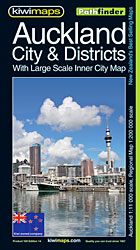
United Kingdom
- Auckland Kiwimaps City & District Pathfinder Map
- Auckland and environs in a series of maps covering various districts of New Zealand, with each title combining a detailed road map with street plans of local towns, all with road and street indexes. The maps are published in two formats: handy Pocket Maps or Pathfinders with, as the publishers put it “Larger print so you don’t squint”.The road... Lire la suite

United Kingdom
- Palmerston North Pathfinder
- Palmerston North region in a series of maps covering various districts of New Zealand, with each title combining a detailed road map with street plans of local towns, all with road and street indexes. The maps are published in two formats: handy Pocket Maps or Pathfinders with, as the publishers put it “Larger print so you don’t squint”.The... Lire la suite

United Kingdom
- NZ542 Motiti Island to Pehitairi Point
- Plans included:Ohiwa Harbour Entrance 1:25,000Whakatane River Entrance 1:7,000Nautical charts for New Zealand, created by Land Information New Zealand (LINZ), are printed on demand at Stanfords after your order is placed and processed. They provide a detailed coverage of the coastline with a varied range of scales - from overall route planning... Lire la suite
